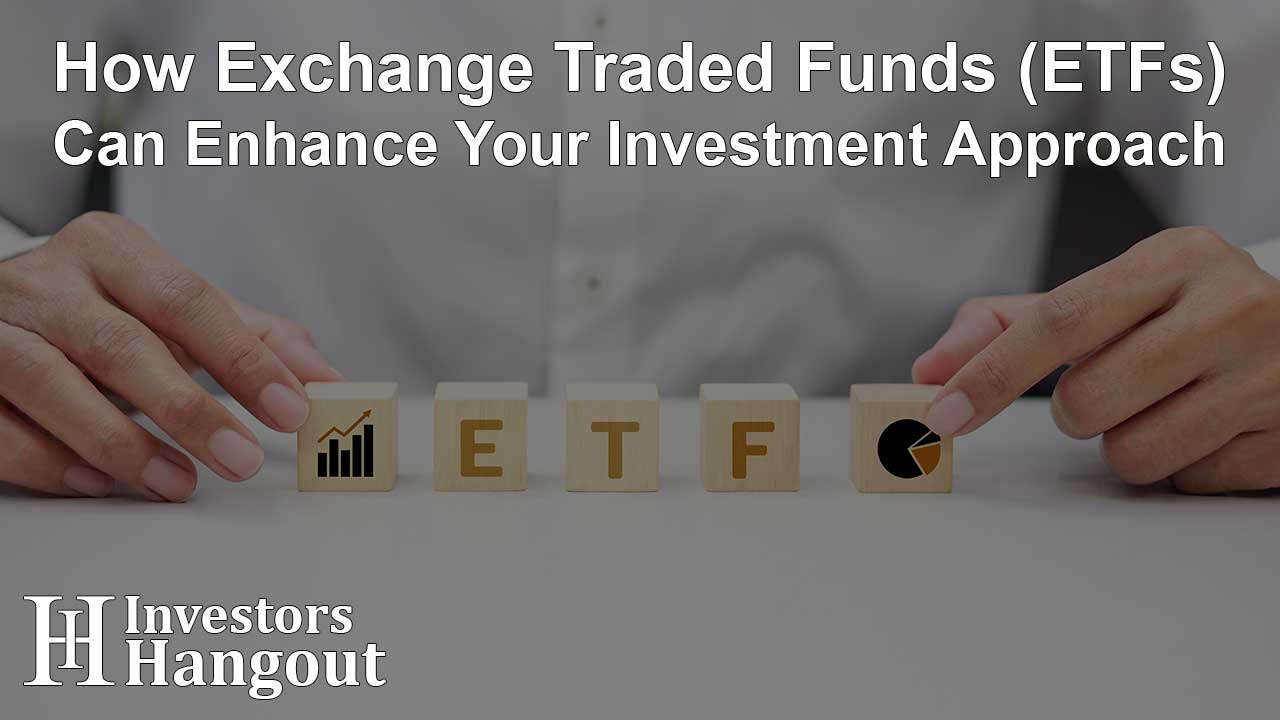How Exchange Traded Funds (ETFs) Can Enhance Your Investment Approach

Transform Your Investment Strategy with ETFs: Benefits and Insights
The world of investing has seen changes over the decades, bringing forth a range of new tools and strategies for individual investors. Among these advancements, Exchange Traded Funds (ETFs) have emerged as an innovative option. ETFs have revolutionized the investment landscape by offering unique opportunities and simplifying the management of investment portfolios. As more individuals recognize the advantages of ETFs, these financial instruments are increasingly becoming integral elements of investment strategies. This article delves into how ETFs can transform your investment approach, providing both seasoned investors and newcomers with insights into the dynamic world of finance.
Understanding ETFs
Essentially, an ETF is an investment fund that consists of a collection of assets such as stocks, bonds, or commodities. Unlike mutual funds, ETFs are traded on stock exchanges, allowing for easy buying and selling throughout the trading day. This key feature distinguishes them from mutual funds, which can only be traded at the end of the day.
- Varieties of ETFs: There are various types of ETFs tailored to different investment objectives. Equity-based ETFs concentrate on stocks and provide exposure to diverse market indices like the S&P 500 or NASDAQ. Bond ETFs contain fixed-income securities that generate income for investors. Sector-specific ETFs focus on industries like technology, healthcare, or energy, enabling investors to benefit from industry trends. Commodity ETFs invest in commodities such as gold, oil, or agricultural products to safeguard against inflation and economic uncertainties.
- Understanding How ETFs Operate: ETFs function similarly to stocks as they can be traded on exchanges. Their prices fluctuate throughout the trading day based on market demand and supply dynamics. This feature allows investors to capitalize on intraday price changes, offering a level of flexibility not found in mutual funds. Generally, ETFs are designed to mirror the performance of an index or benchmark, ensuring they reflect the market or sector they aim to represent.
Advantages of Investing in ETFs
Given these advantages, it is evident why many investors prefer using ETFs to enhance their investment strategies.
- Diversification: A key benefit of investing in ETFs lies in their ability to provide diversification by holding a variety of assets. By spreading risk across multiple securities within the basket, ETFs help reduce the impact of poor performance from any single asset. This built-in diversification feature can aid in stabilizing your investment portfolio and minimizing risks associated with individual holdings. For instance, consider an ETF that mirrors the S&P 500 index, holding shares from 500 companies across various industries and sectors.
- Cost Effectiveness: ETFs generally come with lower expense ratios compared to mutual funds. This is because they are passively managed, tracking an index rather than being actively managed by a fund manager. Reduced costs mean more of your investment earnings stay in your pocket. Furthermore, the competition among ETF providers has pushed costs down even more, making them an appealing choice for cost-conscious investors. Over time, these savings can significantly boost your investment gains.
- Tax Efficiency: ETFs tend to be more tax-efficient than mutual funds. Their distinctive structure allows ETFs to minimize capital gains distributions, resulting in reduced tax obligations for investors. This tax efficiency stems from the creation and redemption process of ETF shares in-kind, helping to avoid triggering capital gains events. Consequently, investors can benefit from deferred tax payments and retain a larger portion of their profits.
- Flexibility and Liquidity: Similar to stocks, ETFs can be bought and sold easily, offering investors the flexibility to enter or exit positions swiftly. This liquidity ensures that there is always a buyer or seller for your ETF shares. When it comes to adapting your investment portfolio based on market changes or easily accessing your money, ETFs provide the versatility required for efficient investment management.
Transforming Your Investment Strategy with ETFs
Integrating ETFs into your investment approach can offer diversification and targeted exposure that aligns with different financial goals.
- Crafting a Varied Investment Mix: ETFs provide a way for investors to diversify their portfolios across various asset classes and sectors without having to purchase individual stocks. For example, one ETF can offer exposure to the S&P 500, giving investors a slice of the entire market. By including a combination of equity, bond, and sector ETFs, you can create a balanced portfolio that manages both risk and potential returns effectively. This strategy simplifies portfolio management and ensures that your investments are spread out across different market segments.
- Managing Risk: Utilizing ETFs to spread investments across diverse assets aids in mitigating risk. Sector-specific and international ETFs can further enhance portfolio diversification, reducing exposure to any single market or industry. If the domestic market is performing below expectations, international ETFs can offer exposure to global economies, balancing out your overall portfolio performance. Moreover, bond ETFs provide stability and help minimize volatility, acting as a safeguard during market downturns.
- Strategic Investing: Leveraging sector and theme-focused ETFs allows investors to capitalize on emerging market trends. For example, if you anticipate growth in the technology sector, investing in a tech-focused ETF could be advantageous. This approach enables you to target specific industries or themes without the need to select individual stocks. Themed ETFs, like those focusing on renewable energy, artificial intelligence, or healthcare innovation, provide exposure to upcoming trends and sectors poised for growth. This strategy lets you take advantage of market opportunities and customize your investments to match your outlook and preferences.
- Generating Income: Dividend ETFs and bond ETFs offer income streams, making them attractive for investors focused on generating income. These ETFs can deliver regular dividend payments or interest income. For retirees or individuals seeking income, dividend ETFs provide access to high-yield stocks that pay dividends. Conversely, bond ETFs invest in a variety of fixed-income securities, offering interest income and stability. This blend of growth and income can help address your financial needs and objectives.
How to Begin with ETFs
Establishing goals and conducting research are essential steps in effectively incorporating ETFs into your investment strategy.
- Defining Objectives: Determine your investment goals and risk tolerance level. Are you aiming for growth, income, or a mix of both? Understanding your objectives is the first step towards creating an investment strategy. Take into account factors such as your time horizon, financial aspirations, and risk tolerance level. These factors will inform your choice of ETFs and assist you in constructing a portfolio that suits your requirements.
- Choosing the Right ETFs: When selecting ETFs, it's important to align them with your goals. Factors like expense ratios, past performance, and the assets they hold should be considered. Opt for ETFs with lower fees to prevent long-term erosion of returns. Evaluate how well an ETF has performed compared to its benchmark and ensure its assets match your investment objectives. For instance, if you aim for growth, focus on equity ETFs with a strong track record and growth potential.
- Monitoring and Rebalancing: Regularly monitor your ETF investments and adjust your portfolio as necessary to maintain your desired asset mix. Use an ETF markets monitor to stay current on the latest trends and performance indicators since market circumstances can change quickly, requiring vigilance for prompt adjustments. Rebalancing involves buying or selling assets periodically to keep your portfolio in line with your investment plan and risk tolerance.
Key Errors to Steer Clear of
By staying vigilant about these pitfalls, you can optimize the advantages of investing in ETFs.
- Avoid overloading your portfolio with one ETF or sector. Diversification is crucial for a balanced approach. While ETFs offer diversification, it's important not to concentrate too much in specific sectors or assets. Spread out your investments across multiple ETFs to minimize risk and enhance overall portfolio stability.
- Watch out for trading fees and expense ratios. Even seemingly low-cost ETFs can accumulate expenses over time if left unchecked. Regularly assess the fees linked to your ETFs and explore lower-cost options if possible. Keeping expenses at a minimum is essential for maximizing returns in the long run.
- Remember that ETFs are susceptible to market fluctuations. Excessive buying and selling can eat into returns due to transaction costs and the risks of timing the market. Focus on a long-term investment plan and resist the urge to engage in frequent trades based on short-term market shifts. Patience and discipline play a crucial role in reaching your financial objectives.
In Conclusion
ETFs serve as a powerful tool for shaping your investment approach by offering diversification, cost-effectiveness, and flexibility suitable for various investment objectives. Whether you're starting out or looking to enhance your portfolio, incorporating ETFs into your strategy can be instrumental in achieving success. By gaining an understanding of how ETFs function and integrating them into your investment plan, you can leverage their benefits to create a well-diversified portfolio. Take a closer look at the world of ETF options and assess how they could complement your investment strategy today.
About The Author
Contact Owen Jenkins privately here. Or send an email with ATTN: Owen Jenkins as the subject to contact@investorshangout.com.
About Investors Hangout
Investors Hangout is a leading online stock forum for financial discussion and learning, offering a wide range of free tools and resources. It draws in traders of all levels, who exchange market knowledge, investigate trading tactics, and keep an eye on industry developments in real time. Featuring financial articles, stock message boards, quotes, charts, company profiles, and live news updates. Through cooperative learning and a wealth of informational resources, it helps users from novices creating their first portfolios to experts honing their techniques. Join Investors Hangout today: https://investorshangout.com/
